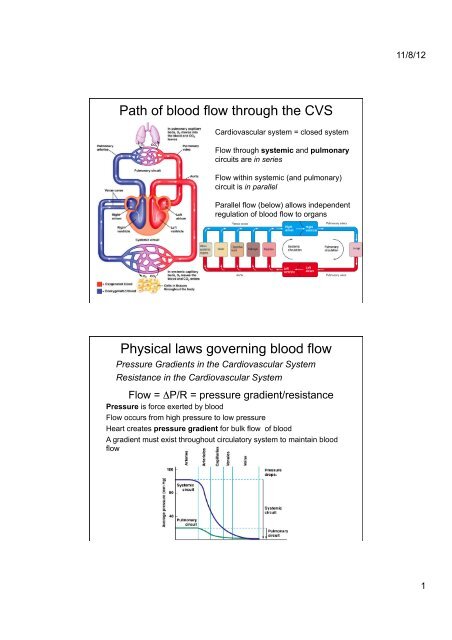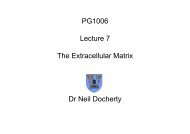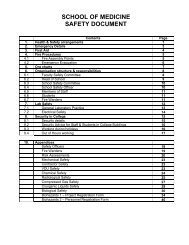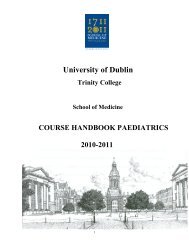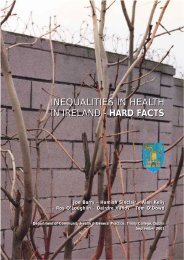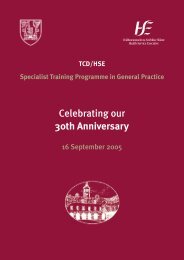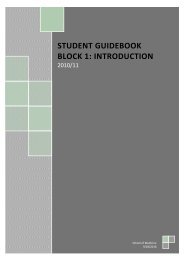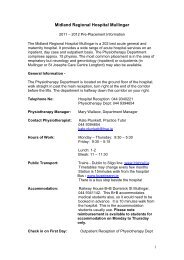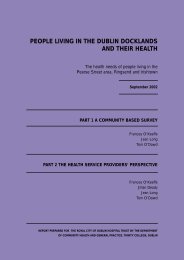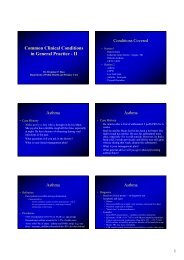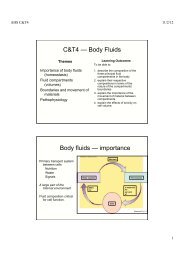Path of blood flow through the CVS Physical laws governing blood ...
Path of blood flow through the CVS Physical laws governing blood ...
Path of blood flow through the CVS Physical laws governing blood ...
Create successful ePaper yourself
Turn your PDF publications into a flip-book with our unique Google optimized e-Paper software.
11/8/12<br />
<strong>Path</strong> <strong>of</strong> <strong>blood</strong> <strong>flow</strong> <strong>through</strong> <strong>the</strong> <strong>CVS</strong><br />
Cardiovascular system = closed system<br />
Flow <strong>through</strong> systemic and pulmonary<br />
circuits are in series<br />
Flow within systemic (and pulmonary)<br />
circuit is in parallel<br />
Parallel <strong>flow</strong> (below) allows independent<br />
regulation <strong>of</strong> <strong>blood</strong> <strong>flow</strong> to organs<br />
<strong>Physical</strong> <strong>laws</strong> <strong>governing</strong> <strong>blood</strong> <strong>flow</strong><br />
Pressure Gradients in <strong>the</strong> Cardiovascular System<br />
Resistance in <strong>the</strong> Cardiovascular System<br />
Flow = ΔP/R = pressure gradient/resistance<br />
Pressure is force exerted by <strong>blood</strong><br />
Flow occurs from high pressure to low pressure<br />
Heart creates pressure gradient for bulk <strong>flow</strong> <strong>of</strong> <strong>blood</strong><br />
A gradient must exist <strong>through</strong>out circulatory system to maintain <strong>blood</strong><br />
<strong>flow</strong><br />
1
11/8/12<br />
Pressure gradient across<br />
pulmonary circuit<br />
Pressure gradient across<br />
systemic circuit<br />
Pressure gradient = pressure in<br />
pulmonary arteries minus pressure in<br />
pulmonary veins just before <strong>the</strong>y empty<br />
into left atrium<br />
Pulmonary arterial pressure = 15 mm Hg<br />
Pulmonary venous pressure = 0 mm Hg<br />
Pressure gradient = 15 – 0 = 15 mm Hg<br />
Pressure gradient = pressure in aorta<br />
minus pressure in vena cava just before<br />
it empties into right atrium<br />
Pressure in aorta = mean arterial<br />
pressure (MAP) = 90 mm Hg<br />
Pressure in vena cava = central venous<br />
pressure (CVP) = 0 mm Hg<br />
Pressure gradient = MAP – CVP = 90 –<br />
0 = 90 mm Hg<br />
Resistance in <strong>the</strong> Cardiovascular System<br />
Systemic circuit: high P, high R; Pulmonary circuit: low P, low R<br />
Effect <strong>of</strong> Resistance on Flow<br />
Remember<br />
Flow = ΔP/R<br />
For any given<br />
pressure, <strong>the</strong> lower<br />
<strong>the</strong> resistance, <strong>the</strong><br />
greater <strong>the</strong> <strong>flow</strong><br />
Factors affecting resistance to <strong>flow</strong>: Poiseuille’s Law<br />
R =<br />
length x viscosity<br />
radius 4<br />
Length <strong>of</strong> vessel (normally doesn’t change)<br />
Viscosity <strong>of</strong> fluid (normally doesn’t change)<br />
Radius <strong>of</strong> vessel: Arterioles (and small arteries) - can regulate radius<br />
RADIUS IS THE MOST IMPORTANT FACTOR<br />
2
11/8/12<br />
Regulate <strong>blood</strong> <strong>flow</strong> by regulating radius<br />
Radius dependent on contraction state<br />
<strong>of</strong> smooth muscle in arteriole wall<br />
Vasoconstriction: increased contraction<br />
(decreased radius)<br />
Vasodilation: decreased contraction<br />
(increased radius)<br />
Functions <strong>of</strong> Varying Arteriole Radius<br />
Controlling <strong>blood</strong> <strong>flow</strong> to individual capillary beds<br />
Regulating mean arterial pressure<br />
The combined resistance <strong>of</strong> all <strong>blood</strong> vessels is termed<br />
TPR: total peripheral resistance. Regional changes in<br />
vasodilation and vasoconstriction can change TPR<br />
Control <strong>of</strong> <strong>blood</strong> <strong>flow</strong> distribution to organs<br />
Regulation <strong>of</strong> <strong>blood</strong> <strong>flow</strong> to organs based on need<br />
(eg to skeletal muscles during exercise)<br />
Regulated by varying radius (and <strong>the</strong>refore resistance)<br />
Organ <strong>blood</strong> <strong>flow</strong> = MAP / organ resistance<br />
ie driving force for <strong>blood</strong> <strong>flow</strong><br />
resistance to <strong>flow</strong> in that organ<br />
For any given P gradient,<br />
<strong>blood</strong> <strong>flow</strong> changes when<br />
resistance changes<br />
3
11/8/12<br />
Factors that influence vasodilation and<br />
vasoconstriction<br />
Autonomic nerves (sympa<strong>the</strong>tic constricts)<br />
Hormones (eg adrenaline constricts)<br />
Metabolism (eg. decreased O 2 causes dilation)<br />
These factors <strong>the</strong>refore influence <strong>blood</strong> <strong>flow</strong><br />
Blood pressure: Mean Arterial Pressure<br />
MAP = driving force for <strong>blood</strong> <strong>flow</strong><br />
F = ΔP/R<br />
Regulating MAP critical to normal function<br />
MAP < normal<br />
Hypotension<br />
Inadequate <strong>blood</strong> <strong>flow</strong> to tissues<br />
MAP > normal<br />
Hypertension (scholarship topic this year)<br />
Stress on heart and walls <strong>of</strong> <strong>blood</strong> vessels<br />
4
11/8/12<br />
Flow = pressure gradient<br />
Regulation <strong>of</strong> MAP<br />
resistance<br />
CO = MAP<br />
TPR<br />
Therefore MAP=CO x TPR = HR x SV x TPR<br />
This means that MAP is completely determined by HR, SV & TPR<br />
Short- and long-term regulation <strong>of</strong> MAP<br />
Short-term regulation<br />
Seconds to minutes<br />
Involves heart &<strong>blood</strong> vessels<br />
Primarily neuronal control<br />
Long-term regulation<br />
Minutes to days<br />
Regulate <strong>blood</strong> volume<br />
Involves kidneys<br />
Primarily hormonal control<br />
This is a classic example <strong>of</strong> <strong>the</strong> different modes <strong>of</strong> action <strong>of</strong><br />
<strong>the</strong> 2 key regulatory systems (nervous & endocrine systems)<br />
Short-Term Regulation <strong>of</strong> MAP<br />
The baroreceptor reflex:<br />
A negative feedback loop that helps maintain<br />
normal <strong>blood</strong> pressure<br />
Baroreceptors = stretch receptors<br />
(mechanoreceptos)<br />
Arterial baroreceptors<br />
High pressure baroreceptors<br />
Sinoaortic baroreceptors<br />
Location<br />
Carotid sinus<br />
Aortic arch<br />
5
11/8/12<br />
Cardiovascular Control Centre<br />
Medulla oblongata<br />
Integration center for <strong>blood</strong> pressure regulation<br />
Output<br />
Sympa<strong>the</strong>tic nerves<br />
Parasympa<strong>the</strong>tic nerves<br />
Sympa<strong>the</strong>tic:<br />
SA node (increase HR)<br />
Ventricles (increase contractility)<br />
Arterioles (increase resistance)<br />
Veins (increase venomotor tone)<br />
Parasympa<strong>the</strong>tic:<br />
SA node (decrease HR)<br />
Major neural pathways in <strong>the</strong> control<br />
<strong>of</strong> cardiovascular function<br />
Baroreceptor Reflex in response to a decrease<br />
in MAP<br />
Components <strong>of</strong><br />
Baroreceptor Reflex<br />
Detectors = baroreceptors<br />
Afferents = nerves<br />
Integration center =<br />
cardiovascular control center<br />
Efferents = autonomic nervous<br />
system<br />
Effectors = heart, arterioles,<br />
veins<br />
6
11/8/12<br />
Physiology Research Focus: hypertension<br />
(scholarship topic 2012/13)<br />
Hypertension and diabetes<br />
are frequent comorbidities<br />
Serious problem in developed<br />
countries, increasing problem<br />
in developing countries<br />
Factors associated with hypertension<br />
Figures taken from scholarship special reading journal articles<br />
Physiology Research Focus: hypertension<br />
(scholarship topic 2012/13)<br />
Drugs & medical devices are in development. We can only develop<br />
effective treatments if we understand <strong>the</strong> Physiology underlying <strong>the</strong> disease<br />
Figures taken from scholarship special reading journal articles<br />
7


